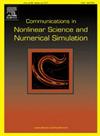关于Lennard-Jones链的微观状态方程
IF 3.4
2区 数学
Q1 MATHEMATICS, APPLIED
Communications in Nonlinear Science and Numerical Simulation
Pub Date : 2025-04-21
DOI:10.1016/j.cnsns.2025.108843
引用次数: 0
摘要
局部热力学平衡假设是在平衡和非平衡状态下使用热力学概念和联系它们的关系的基础。它的适用领域在不同的系统中可能有很大的不同。一维粒子系统经常违反该假设所要求的局部性条件,因为相关性可以持续很长的距离和时间。利用范德瓦尔斯方程的微观模拟,其中涉及压力、温度和密度的微观力学等效,我们研究了最近提出的一个关于温度和密度的微观力学等效状态方程的非平衡关系,对于一维粒子链的有效性。我们这样做不需要援引局部平衡假设:因为我们处理的是机械量,而不是热力学量,所以我们不需要局部平衡假设。描述了这种关系的起源和有效性,并给出了为什么它在各种感兴趣的制度中起作用的迹象。有趣的是,在我们的Lennard-Jones系统中,当微观“温度”局部升高或微观“密度”降低时,这种关系似乎得到了更好的满足。这些条件分别由边界处的高“温度”差和增加链的长度所有利。在这些状态点上,线性关系可以看作是我们提出的范德瓦尔斯方程的微观模拟。在某些情况下,也存在基于这种联系的更简单的近似。这些类型的关系非常适用于大得惊人的非平衡状态和物理意义上的重大范围。本文章由计算机程序翻译,如有差异,请以英文原文为准。
On a microscopic equation of state for Lennard-Jones chains
The local thermodynamic equilibrium hypothesis is fundamental to the use of thermodynamic notions and the relations linking them, in equilibrium as well as nonequilibrium states. Its domain of applicability can vary widely across different systems. Monodimensional particle systems often violate the locality condition required by that hypothesis, because correlations can persist over long distances and times. Using a microscopic analogue of the van der Waals equation, which involves the microscopic mechanical equivalent of pressure, temperature and density, we investigate the validity of one of the nonequilibrium relations recently proposed as an equation of state concerning the microscopic mechanical equivalent of temperature and density, for monodimensional chains of particles. We do this without invoking the local equilibrium hypothesis: as we deal with mechanical, not thermodynamic, quantities, we do not need the local equilibrium hypothesis. The origin and validity of such a relation are described and indications are given as to why it works in various regimes of interest. Interestingly, that relation appears to be better satisfied, in our Lennard-Jones systems, when the microscopic “temperature” grows locally or the microscopic “density” decreases. These conditions are respectively favoured by high “temperature” differences at the boundaries, and by increasing the length of the chains. At those state points, that linear relation can be seen as a microscopic analogue of the van der Waals equation we propose. In some cases, a simpler approximation based on that link also exists. These types of relations work quite well for a surprisingly large and physically significant range of nonequilibrium states.
求助全文
通过发布文献求助,成功后即可免费获取论文全文。
去求助
来源期刊

Communications in Nonlinear Science and Numerical Simulation
MATHEMATICS, APPLIED-MATHEMATICS, INTERDISCIPLINARY APPLICATIONS
CiteScore
6.80
自引率
7.70%
发文量
378
审稿时长
78 days
期刊介绍:
The journal publishes original research findings on experimental observation, mathematical modeling, theoretical analysis and numerical simulation, for more accurate description, better prediction or novel application, of nonlinear phenomena in science and engineering. It offers a venue for researchers to make rapid exchange of ideas and techniques in nonlinear science and complexity.
The submission of manuscripts with cross-disciplinary approaches in nonlinear science and complexity is particularly encouraged.
Topics of interest:
Nonlinear differential or delay equations, Lie group analysis and asymptotic methods, Discontinuous systems, Fractals, Fractional calculus and dynamics, Nonlinear effects in quantum mechanics, Nonlinear stochastic processes, Experimental nonlinear science, Time-series and signal analysis, Computational methods and simulations in nonlinear science and engineering, Control of dynamical systems, Synchronization, Lyapunov analysis, High-dimensional chaos and turbulence, Chaos in Hamiltonian systems, Integrable systems and solitons, Collective behavior in many-body systems, Biological physics and networks, Nonlinear mechanical systems, Complex systems and complexity.
No length limitation for contributions is set, but only concisely written manuscripts are published. Brief papers are published on the basis of Rapid Communications. Discussions of previously published papers are welcome.
 求助内容:
求助内容: 应助结果提醒方式:
应助结果提醒方式:


